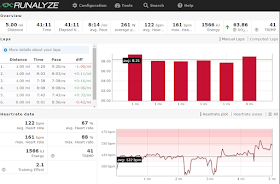I've had my Stryd power pod for about 10 days and I've run every single day with it! I love this little pod and all the data that comes with it. Still don't know all the details or how to best utilize it for training and racing, but it has motivated me to run more, with greater variety, and to think about my runs. Power is correlated with heart rate, but it is a more direct measure of your effort. Cyclists have used power meters for years, now runners have the same option. I'm excited to see what this tool can do for my running and racing.
Post-run analysis is rather fun. Lots of numbers, charts, and graphs. I need to do a "functional threshold power test" (critical power) to better establish my personal power zones, but I started with entering a recent race time to estimate zones. Here is an example of the data from the Stryd power center (their software tool) for a recent 5-mile treadmill run:
My maximum power output was 358 watts, average was 261 watts. The max power reading came when I pushed the pace to 6:00 minutes/mile! It also tracks ground contact time, vertical oscillation, leg spring stiffness, fatigue, power used on form rather than forward propulsion (77.2 watts in this run) and a few of other stats I haven't figured out. Trends over time are also displayed (but I need more data). Stryd also provides training programs based on power zones. Might use one for a fall half-marathon.
The same 5-mile run viewed within the Runalyze web-based program (the best free running software available):
Once I have real power zones, I'll be able to adjust training and racing with power numbers displayed on my Garmin watch. After about 30 days, Stryd starts to give insights and analysis based on your past and current fitness. I'm definitely happy with this device after 10 days, but the real proof will be after 30 days...and after my first couple of races where I monitor power during the race.



No comments:
Post a Comment